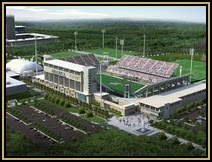 When others saw risk, Beaumont native Lee McElroy found opportunity. The oldest of 12siblings, the former Hebert High School football star became the first to go as far from home has he did.
When others saw risk, Beaumont native Lee McElroy found opportunity. The oldest of 12siblings, the former Hebert High School football star became the first to go as far from home has he did.
Years later, an unexpected career shift took him from home again, this time on a journey that has allowed him to make as bigger a difference off the field than he ever did on it.
Through it all, McElroy points to a racially segregated upbringing that shaped his values today, as he is one of few African-Americans to run an athletic program at a non-traditionally-black school. "I've had a lot of success everywhere I've been, and that's because I learned to go in and look at an environment and then develop the pieces to make it fit," said McElroy, the director of athletics at New York's University of Albany since 2000.
McElroy, 60, is an older brother to former National Football League players Reggie and Leeland McElroy. Their greatest impacts came on the field, Reggie through 15 years as an offensive lineman and Leeland through three years as a running back.
Although a good enough football player to be a linebacker at UCLA, Lee McElroy's impact came in the classroom. His father the mail carrier and his mother the teacher's aide stressed getting an education. They said his six brothers and five sisters looked to him as an example."Very early on you learned responsibility and accountability," said McElroy, expected to be the first to the dinner table and to make sure the doors were locked for the night.
Branching out
McElroy's responsibilities today include overseeing an expanding athletic department and trying to get financing for an on-campus football stadium. Those tasks, however, were far beyond McElroy's horizon when he left Beaumont for what he called the "culture shock" of UCLA in 1966."Lee wasn't afraid to branch out," said one of McElroy's former Hebert teammates, Bob Pollard, who played 11 seasons in the NFL.
Pollard recalled that he and other Hebert teammates didn't stray beyond Texas Southern University in Houston at a time when McElroy made his cross-country leap.
"There were four or five guys that went to Texas Southern, but he was going all the way to UCLA," said Pollard, who transferred after one season at Texas Southern to Weber State in Utah. "He wanted to branch out and prove that he could compete, not just athletically, but academically as well."
Although McElroy took academics seriously, he felt he had more to prove in the segregated setting that surrounded Hebert."We had to overcome the stigma and perceptions that our school wasn't as good academically (as schools with mostly white students)," McElroy said of Hebert, housed on the site that is now Ozen. "We had to overcome the perception that our school was inferior and that the experience was inferior." With a bachelor's in political science from UCLA and a master's in education from Southern California, McElroy returned to Beaumont to be a teacher and coach at South Park High School in 1975. He became an assistant principal at Forest Park in 1979 and envisioned a future in academic administration before his career took an unexpected turn in 1981.
"My original intention was to remain in Beaumont," said McElroy, who had completed courses at UH to become a school superintendent. But, at the behest of then-UH athletic director Cedric Dempsey, McElroy joined the school's athletic department and started what he said was the first academic support program for athletes in the now-defunct Southwest Conference.
Pride and scorn
McElroy spent eight years at UH and went to three other universities, including Albany. He also served as athletics director for four years at American University in Washington D.C., seven years at California State University-Sacramento and one year at the University of District of Columbia. With McElroy, Albany is among four percent of universities with mostly white students to have an African-American athletic director; a statistic McElroy declares "a source of pride and a source of scorn." The pride comes with an achievement that has allowed him to stand tall, as he was recognized enough to have served as the president of the National Association of Athletic Directors for the 2007-07 academic term. McElroy's scorn that lies in his desire that blacks be given as much opportunity as whites.
"I'm a little tired of hearing from people in the industry who are saying that the only people who can make a change are the university presidents," McElroy said.
To McElroy, raising the number of black administrators and coaches to reflect the amount of black athletes - close to 60 percent in Division I basketball and 45 percent in Division I football, according to NCAA data - must be an industry-wide effort.
"Look at the way the NFL has worked," McElroy said of the "Rooney Rule," which requires all teams to interview at least one minority for all head coaching positions. "Why can't we do the same thing in the NCAA? You interview quality people of color." At most schools, the athletic director and football coach are often the public face of a university, McElroy said. "In the south, if a person of color is the point person, he may not be able to raise enough money," McElroy said. "That's got to change."
Changes at home
Yet, for as much change McElroy would like to see in the NCAA, he has seen more change in his home town. Gone is the segregated environment in which whites had "no contact athletically and educationally with anyone who was African-American."
McElroy pointed to the merger of all-black Hebert and all-white Forest Park to create West Brook and its Class 5A football state title that followed in 1982 as an eye opener. "That showed what integration could do," he said.
McElroy returns home for annual visits with his mother, where he continues to bump into those whose lives he touched during his brief return to Beaumont. "He's always been highly academically oriented," said Arthur Louis, who was coached by McElroy at South Park and is now an assistant football and track coach at West Brook. "He always talked with me about being the complete student athlete, which is what I talk about today." Although McElroy said he is happy to live in Albany - he recently took dance lessons with his wife, Karen, to prepare for a local charity "Dancing with the Stars" event - he might be open to another move, but only under proper circumstances. "I'm having so much fun here," he said. "The community is behind us and the state of New York is getting behind what we've done. What I want to do now is build a (football stadium), so I can't say what tomorrow will bring."
By CHRISTOPHER DABE
Wednesday, July 2, 2008
Former Football Star Lee McElroy and His Journey to University of Albany
Posted by
BRE
at
5:29 AM
![]()
Labels: Dr. Lee McElroy, UAlbany sports, University of Albany
Subscribe to:
Post Comments (Atom)

.jpg)




.jpg)
+(2).jpg)
.jpg)
.jpg)

.jpg)
+(2).jpg)
+(2).jpg)
+(2).jpg)
_(2)+(2).jpg)
+(2).jpg)
+(2).jpg)
_(2)+(2).jpg)
+(2).jpg)


.jpg)
.jpg)
+(2).png)
+(2).jpg)
.jpg)
.jpg)
+(2).jpg)
+(2).jpg)
+(2).jpg)
.jpg)
+(2).jpg)
+(2).jpg)
+(2).jpg)
_(2)+(2).jpg)
+(2).jpg)
.jpg)
+(2).jpg)
+(2).jpg)
+(2).jpg)
.jpg)
.jpg)
+(2).png)
.jpg)
.jpg)
.jpg)
.jpg)
+(2).jpg)
+(2).jpg)

.jpg)

+(2).jpg)
.jpg)
.jpg)
.jpg)
.jpg)
.jpg)
.jpg)
.jpg)
.jpg)
.jpg)
.jpg)
.jpg)
.jpg)
.jpg)
.jpg)
.jpg)
.png)
.png)
.jpg)
.jpg)
.jpg)
.jpg)
.jpg)
.jpg)
+(2).jpg)
.jpg)
+(2).jpg)
.jpg)
+(2).jpg)
.jpg)
.jpg)
.jpg)
.jpg)
.jpg)
.jpg)
.jpg)
.jpg)
.jpg)
.jpg)
.jpg)
.jpg)
.jpg)
.jpg)
.jpg)
.jpg)
.jpg)
.jpg)
.jpg)
.jpg)
.jpg)
.jpg)
.jpg)
.jpg)
.jpg)
.jpg)
.jpg)
.jpg)
.jpg)
.jpg)
.jpg)
.jpg)
.jpg)
.jpg)




No comments:
Post a Comment